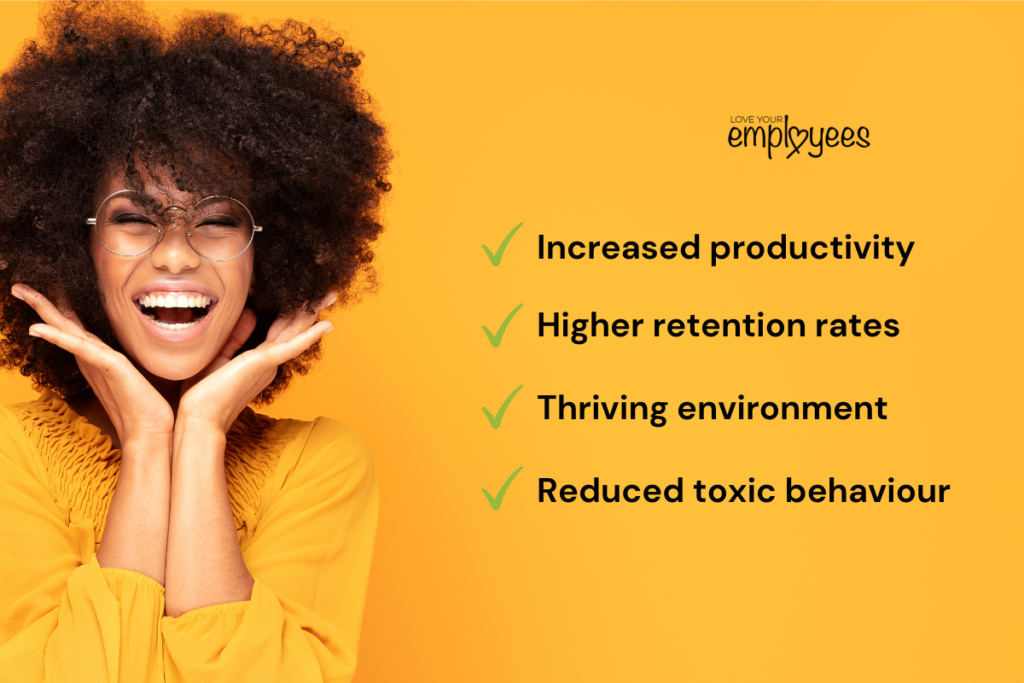Why is Emotional Wellbeing important?

In today’s fast-paced and demanding work environments, it is essential for businesses and organisations to prioritise the emotional wellbeing of their employees. Cultivating emotional wellbeing in the workplace not only promotes a positive work culture but also enhances productivity and overall job satisfaction. In this article, we will explore some key considerations for organisations. In a Love Your Employees context, emotional wellbeing is a key element of the Mental Wellbeing pillar.
Foster Open Communication
Creating an environment that encourages open communication is crucial for supporting emotional wellbeing. Employees should feel comfortable expressing their thoughts, concerns, and emotions without fear of judgment or reprisal. Encourage regular feedback sessions, provide platforms for anonymous suggestions, and promote transparent and honest communication channels. If you are unsure how to build these types of channels there are lots of advice, tips and solutions out there to help.
Develop a Supportive Leadership Style
Leaders play a pivotal role in establishing and shaping the emotional wellbeing of their teams. A supportive leadership style involves active listening, empathy, and providing guidance when needed. Encourage leaders and managers to establish strong relationships with their team members, foster trust, and create a safe space for open dialogue. This is often a sticking point for organisations due to “old school” leadership practices, many of which give rise to toxic behaviours.
Encourage Work-Life Balance
Striking a healthy work-life balance is vital for emotional wellbeing. Encourage employees to set boundaries and prioritise their personal lives outside of work. Flexible working hours, remote work options, and policies that promote self-care can contribute significantly and prevent burnout. Every team member should be aware of their responsibilities in observing and respecting their colleagues’ boundaries. With increasing flexibility of working practices this can be problematic and tools such as email automation and scheduling should be used.
Promote Emotional Intelligence
Emotional intelligence is the ability to understand and manage one’s own emotions and effectively navigate social interactions. Promote emotional intelligence within your organisation by providing training and workshops that help employees develop self-awareness, empathy, and effective communication skills. This can lead to improved relationships, reduced conflicts, and enhanced emotional wellbeing. There are also multiple books on this subject that are extremely useful and informative. Apps such as Blinkist and Uptime are also great for training, education and personal growth.
Create a Positive Work Environment
A positive work environment contributes to emotional wellbeing by fostering a sense of belonging and happiness. Encourage teamwork, celebrate achievements, and recognise employees’ efforts. Create spaces where employees can relax, recharge, and build relationships with their colleagues. Promoting a culture of gratitude and appreciation can go a long way! A simple thank you or acknowledgement of someone’s efforts is sometimes all it takes. Be kind.
Provide Resources and Support
Ensure that employees have access to resources and support systems for managing their emotional wellbeing. This can include offering counseling services, Employee Assistance Programs (EAPs), mental health resources, and wellness initiatives. Educate employees about these resources and promote their utilisation to destigmatise seeking help when needed. Our marketplace has many providers that can support individuals, and there are a wealth of free support sources out there. Why not create a library of these and make sure you consistently remind your people that they are there?
Regularly Evaluate and Adapt
Emotional wellbeing is not a one-time fix; it requires ongoing attention and evaluation. Regularly assess the effectiveness of your initiatives, gather feedback from employees, and make necessary adjustments. Stay up to date with best practices and industry trends in employee emotional wellbeing to continuously improve and adapt your strategies. We can help you build the necessary processes to make this happen, get in touch and we can explain exactly how we do it.
Be consistent, these things take time and don’t happen overnight!
Cultivating emotional wellbeing in the workplace is a holistic approach that requires commitment, empathy, and a supportive organisational culture. By implementing these key considerations, you can create an environment where employees feel valued, supported, and emotionally fulfilled. Investing in emotional wellbeing not only benefits individuals but also leads to increased productivity, higher retention rates, and a thriving work environment. Together, let’s prioritise emotional wellbeing and create workplaces that nurture the whole person.
